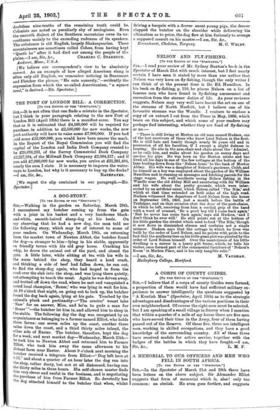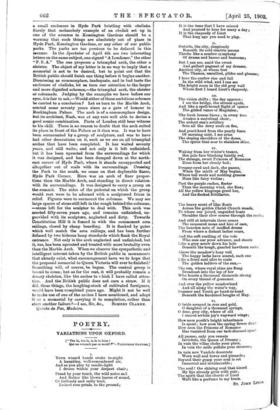A MEMORIAL TO OUR OFFICERS AND MEN WHO FELL IN
SOUTH AFRICA.
[To THE EDITOR OF THE Srsorkros..1 SIR,—In the Spectator of March 21st and 28th there have been letters on the above subject. Sir Alexander Elliot suggests that form of memorial which is, alas ! only too common: an obelisk. He even goes further, and suggests a small enclosure in Hyde Park bristling with obelisks. Surely that melancholy example of an obelisk set up in one of the avenues in Kensington Gardens should be a warning that such things are absolutely out of place in Hyde Park, Kensington Gardens, or any other of our public parks. The parks are too precious to be defaced in this manner. In the Spectator of April 4th are two interesting letters on the same subject, one signed "A Londoner," the other "F. S. A." The one proposes a triumphal arch, the other a cloister. The object of my letter is in no way to imply that a memorial is not to be desired, but to point out that the British public should finish one thing before it begins another. Dismissing as commonplace, inadequate, and in had taste the enclosure of obelisks, let us turn our attention to the larger and more dignified schemes,—the triumphal arch, the cloister or colonnade. Judging by the examples we have before our eyes, it is fair to ask,—Would either of these ambitious schemes be carried to a conclusion ? Let us turn to the Marble Arch, erected some seventy years since as a gate of honour to Buckingham Palace. The arch is of a commonplace design, but its architect, Nash, was at any rate well able to devise a good scenic combination. Parts of London still bear witness to his skill. There is no reason to doubt that the arch suited its place in front of the Palace as it then was. It was to have been surmounted by a group of sculpture, and was to have had other decorations on it, such as we see on all triumphal arches that have been completed. It has waited seventy years, and still waits; and not only is it left unfinished, but it has been uprooted from the surroundings for which it was designed, and has been dumped down at the north- east corner of Hyde Park, where it stands unsupported and altogether out of scale with its surroundings. Crossing the Park to the south, we come on that deplorable fiasco, Hyde Park Corner. Here was an arch of finer propor- tions than the Marble Arch, and standing in direct relation with its surroundings. It was designed to carry a group on the summit. The sides of the pedestal on which the group would rest were to be adorned with a sculptured frieze in relief. Figures were to surmount the columns. We may see large spaces of stone still left in the rough behind the columns, —stone left for the sculptor to deal with. This arch was erected fifty-seven years ago, and remains unfinished, un- provided with its sculpture, neglected and dirty. Towards Constitution Hill it is fenced in with the commonest area railings, closed by cheap boarding. It is flanked by gates which well match the area railings, and has been further defaced by two hideous lamp standards which flank the Royal entrance. Not only is the arch neglected and aafinished, but it, too, has been uprooted and treated with more brutality even than the Marble Arch. When we observe the sympathetic and intelligent interest taken by the British public in monuments that already exist, what encouragement have we to hope that the proposed memorial to Queen Victoria will ever be finished? Something will, of course, be begun. The central group is bound to come;. but as for the rest, it will probably remain a dreary skeleton, like the arches to 'r hick I have called atten- tion. And the British public does not care a straw. If it did, these things, the laughing-stock of cultivated foreigners, would have been completed years ago. Might it not be well to make use of one of the arches I have mentioned, and adopt it as a memorial by carrying it to completion, rather than start another failure ?—I am, Sir, &c., SOMERS CLARKE. Quinta da Paz, Madeira.



























































 Previous page
Previous page